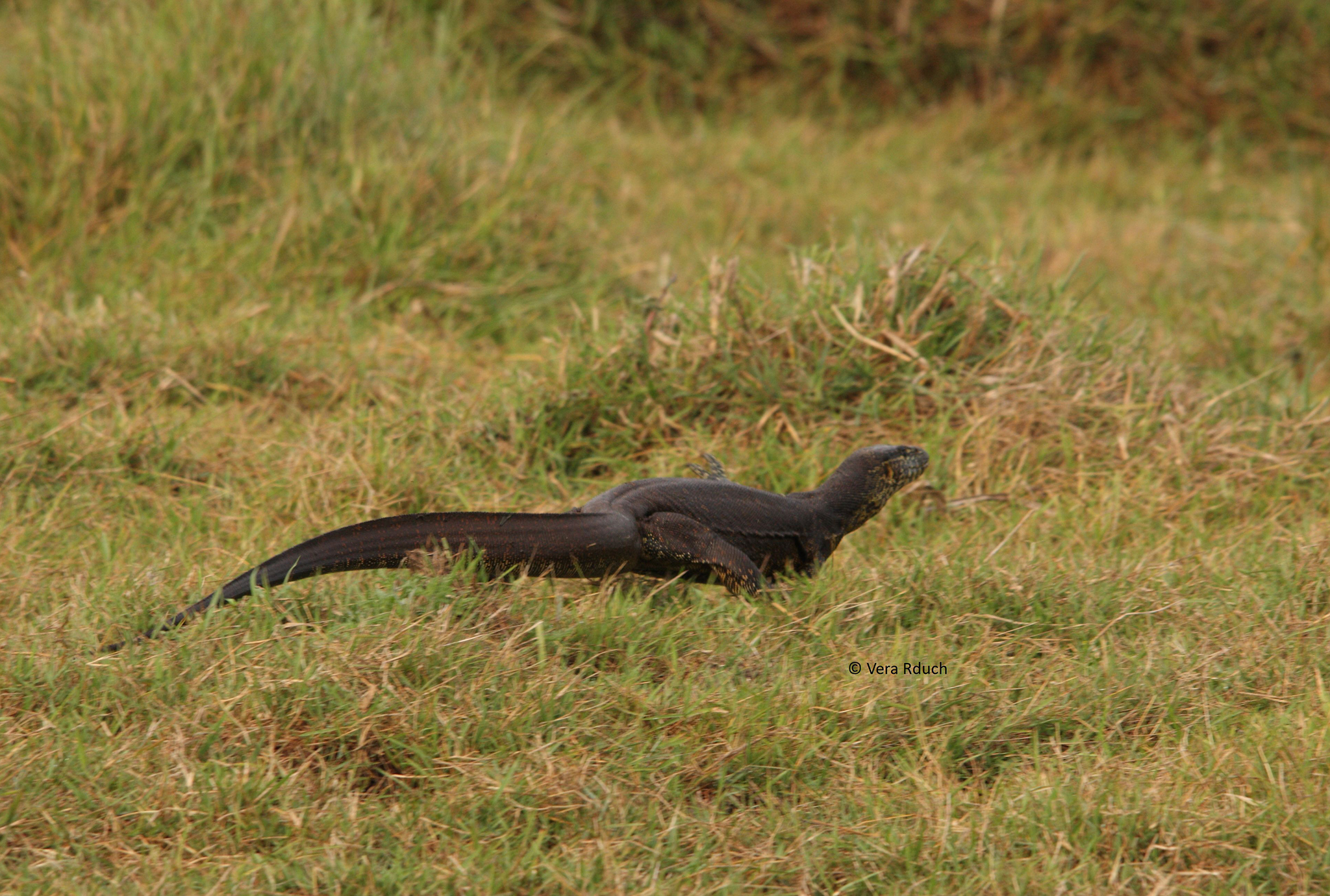Our treasure of the month first discovered in Africa: black Nile monitor lizard
 A large melanistic (probably male) Nile monitor (Varanus niloticus) on the run. Kasanka National Park, Zambia, 3 November 2010 © Vera Rduch
A large melanistic (probably male) Nile monitor (Varanus niloticus) on the run. Kasanka National Park, Zambia, 3 November 2010 © Vera Rduch
The largest lizards on earth, monitor lizards inhabit various habitats in tropical and subtropical areas of Africa, Asia and Australia. The species exhibit extremely diverse colors and color patterns. For example, there is the bright green emerald monitor (Varanus prasinus), but also species with dot patterns or cross banding. Often the color is adapted to the habitat, serves as camouflage or contains intraspecific signals.
Even within one species of monitor lizards, coloration can vary. Black specimens are found more or less regularly in populations of different species. This black coloration is called melanism, a dark pigmentation of skin, hair, scales by very dark brown or black color pigments (melanins) occurring in the animal kingdom. “Black panthers”, black individuals of leopard or jaguar, are considered the best known. Black coloration is often genetically determined. The causes that black coloration occurs are quite different: Sometimes increased sunlight, greater humidity, lower temperature, or other factors cause individuals to be black in color. What evolutionary advantage black coloration may bring is often unknown.
Melanism in reptiles is actually a common phenomenon and is often associated with thermoregulatory benefits. In some species, entire populations may be black in color. In most cases, however, these are only isolated findings within normally colored populations. In several groups of the family Varanidae black individuals have been found so far. But the animal in question, our treasure of the month, is the first and only record of a melanistic monitor lizard of the subgenus Polydaedalus on the entire continent of Africa: the first black Nile monitor lizard, Varanus (Polydaedalus) niloticus.
However, there was no herpetologist in the field to specifically look for the black Nile monitor. It was Dr. Vera Rduch, one of our mammalogists, who was on her way to Zambia for her research on antelopes. The enthusiastic zoologist and photographer saw this monitor lizard flitting in front of her camera – only a very short moment, but it was enough for a “snapshot”. After her return to Germany, she exchanged views with her colleagues in reptile research, who were particularly interested in her observations of the monitor lizards. In fact, Prof. Dr. Wolfgang Böhme immediately noticed that this monitor lizard in the pictures was special. Quite incidentally, and almost by chance, it turned out that the picture was the very first evidence for a melanistic Nile monitor. This photographic documentation was presented in a scientific publication last year in connection with melanism within the monitor lizards.
Our collections include several million specimens of a wide variety of animal species, including parts of species. Like all other collections, the tissue collection is constantly growing, providing material for genetic analyses. At the same time, there is a significant photographic database that provides essential scientific data in addition to the better-known collections. This is where the find is now recorded. With the inclusion of an image in the database, defined minimum requirements are fulfilled that apply to all scientific collections: In addition to a reliable determination of the species, i.e. the species name, the exact date of capture as well as information such as the habitat are recorded. Our experts check all data for accuracy before they are entered into the database. Of course, we take a special look at specially protected species with conservation significance.
Worldwide, 82 described monitor species are currently protected by CITES, the Washington Convention on International Trade in Endangered Species of Wild Fauna and Flora. The uncontrolled trade of live monitor lizards for the pet market and their skins for the leather industry threatens many of these species. Thousands of monitor lizards and monitor lizard skins are imported into Germany each year for the leather industry. Unfortunately, the 82 scientifically described species are often very difficult to distinguish from each other. The LIB, together with the German Federal Agency for Nature Conservation, was instrumental in developing a visual identification aid for the world’s monitor lizard species. In order to be able to really protect monitor lizards, the different species must also be clearly identified.
Further information on melanism in monitor lizards can be found in the publication accompanying this finding:
Melanism in monitor lizards (Squamata: Varanidae), with a first case in the Nile Monitor, Varanus (Polydaedalus) niloticus (Squamata: Varanidae)
by Wolfgang Böhme, Thore Koppetsch and Vera Rduch in Herpetology Notes, volume 15: 257-262 (2022) (published online on 26 April 2022)
https://www.biotaxa.org/hn/article/view/72870
And here is the identification key (click pdf):
https://www.bfn.de/publikationen/bfn-schriften/bfn-schriften-554-visuelle-bestimmungshilfe-fuer-die-waranarten-der


